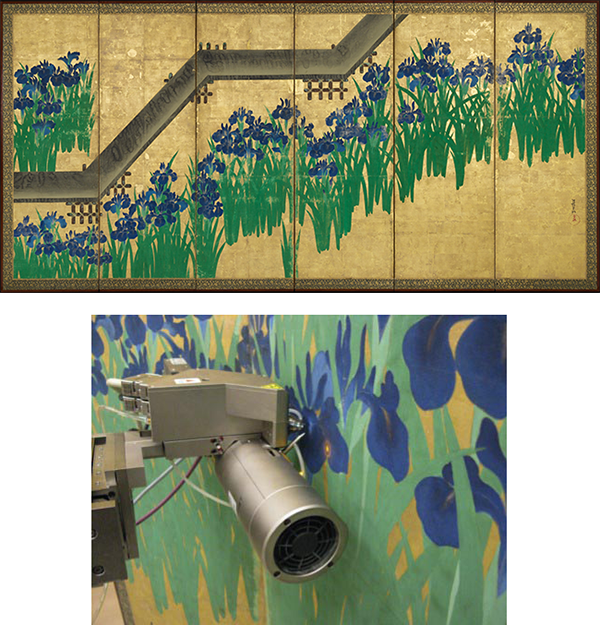Reading Art through Science
In the basement of one of the world’s largest museums, Pablo Londero was handling a chip of paint no bigger than a flea. By placing it in a laser beam and analyzing the light it emitted, he was trying to figure out what sorts of pigments were on the chip. He hoped for a clear answer from this one sample: he had scraped it from a 17th century terracotta made by Luisa Roldán—the first female sculptor to work for the Spanish royal court—and didn’t relish the idea of creating another small defect in the priceless statue.
Examining ancient and valuable works of art is a daily task in the science department of New York’s Metropolitan Museum of Art, where Londero is carrying out his postdoctoral research. The Physics editors visited this lab of 14 chemists, physicists, and materials scientists to get a glance of the vibrant, behind-the-scenes activity that supports the museum’s life.
Like many research labs, the Met’s science department has an impressive collection of lasers, electron microscopes, and x-ray machines. Here, though, the scientists use these tools to study Egyptian mummies, pinpoint the conditions that cause daguerreotypes to whiten with age, or determine the inks used to pen 18th century manuscripts. They also help curators decide in which humidity and lighting conditions to store and display art.
Delving into these puzzles requires a very broad knowledge of the physics and chemistry of materials. “A collection like the Met’s spans five thousand years of human history and comprises all kinds of materials—wood, textiles, glass, metals, coloring pigments—each with a unique, and, most of the time, unknown, history of environmental changes, restoration, or embellishment,” said head of the department Marco Leona, a chemist with a background in crystallography.
By analyzing the materials that make up an artwork, these scientists can open gateways to the past. “One can see works of art as complex technological objects, composed of materials manipulated by an artist to produce a certain effect,” explained Leona. “Through the ‘materiality’ of a piece we can learn something about the artist as a person who existed at a specific point in time, in a specific place and society, with access to certain knowledge and technologies.”
Materials, he told us, can reveal whether certain artworks are related and along which trade routes they travelled. In 2009, a museum conservator asked Leona and his team to examine two 12th century wooden statues from France: the Morgan Madonna and the Montvianeix Madonna. Stylistically, the statues were similar, but had they, in fact, been crafted by the same hands? The researchers analyzed trace amounts of purple glazing on both statues and found it was made of lac, an insect dye coming from South Asia. The surprising discovery (lac was thought to have arrived in Europe long after the 12th century) not only suggested the two objects came from the same workshop, but also provided a rare glimpse into the globalized trade at the times of the Crusades.
Studies like these require ultrasensitive and minimally invasive experiments. Londero, who worked on laser physics at Cornell, now develops new technologies to identify small traces of pigments. These days, he is improving a laser-based technique called surface-enhanced Raman scattering (SERS), which finds the unique “fingerprints” of a pigment by measuring the characteristic vibrations of its molecules with light. He uses a trick to boost the SERS detection sensitivity: a laser ablates some of the molecules and deposits them on a surface layered with silver nanoparticles, which amplify the molecules’ interaction with light. Londero will use this technique to find out the paint composition of the Roldán chip, hoping to gain some insight into her techniques.
In many ways, Leona and his colleagues are traditional scientists: they publish their work in physics and chemistry journals, host Ph.D. students, and collaborate with and teach at leading universities. What is different is that they exploit the explanatory power of science to answer questions on art and history. Hints of their broad interests line their desks: books on laser physics sit next to texts on ancient metallurgy practices, Cambodian history, or Italian Renaissance painters.
The interdisciplinary nature of their work can make it challenging to carve out a career path or find funding opportunities—much of the work falls outside the boundaries of traditional disciplines. But these scientists do enjoy the rare privilege of combining the appreciation of science and art in their daily work. They are equally enthusiastic contemplating an ancient masterwork or scanning it with an x-ray beam: “To me, perceiving artistic beauty has the same feeling as solving a scientific riddle,” said Leona, “I ended up in this line of work for the same reason I was in science in the first place: driven by curiosity.”
– Matteo Rini, Deputy Editor





